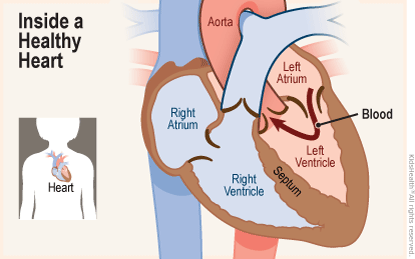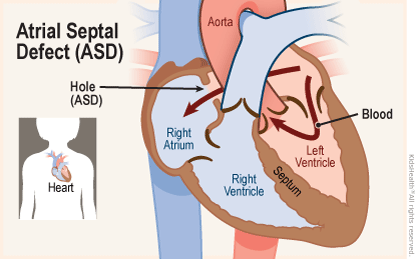How To Repair An Atrial Septal Defect
What Is an Atrial Septal Defect?
An atrial septal defect (ASD) — sometimes called a hole in the centre — is a blazon of built heart defect in which there is an abnormal opening in the dividing wall between the upper filling chambers of the heart (the atria).
In most cases, ASDs are diagnosed and treated successfully with few or no complications.
What Happens in an Atrial Septal Defect?
In an atrial septal defect, there'due south an opening in the wall (septum) between the atria. As a result, some oxygenated blood from the left atrium flows through the hole in the septum into the right atrium, where it mixes with oxygen-poor blood and increases the total amount of claret that flows toward the lungs.

The increased claret period to the lungs creates a swishing sound, known equally a heart murmur. The murmur, along with other specific heart sounds, often is the first tip-off to a doctor that a child has an ASD. ASDs tin be in dissimilar places on the atrial septum and can vary in size.
What Causes Atrial Septal Defects?
Children with ASDs are born with the defect. ASDs happen during fetal development of the eye. The heart develops from a big tube, dividing into sections that will somewhen become its walls and chambers. If in that location's a trouble during this procedure, a hole tin can form in the wall that divides the left atrium from the right.
In some cases, the tendency to develop an ASD might be inherited (genetic). Genetic syndromes can crusade actress or missing pieces of chromosomes that can be associated with ASD. Most ASDs, though, have no clear crusade. It's also not clear why ASDs are more common in girls than in boys.
What Are the Signs & Symptoms of an Atrial Septal Defect?

The symptoms caused by an ASD depend on its size and its location. Virtually kids who accept ASDs seem healthy and appear to take no symptoms. Most grow and gain weight unremarkably.
Children with larger, more severe ASDs, though, might take some of these signs or symptoms:
- poor ambition
- poor growth
- farthermost tiredness
- shortness of breath
- lung problems and infections, such equally pneumonia
What Problems Can Happen?
An ASD that isn't treated in childhood tin lead to wellness problems afterward, including an abnormal heart rhythm (an atrial arrhythmia) and problems in how well the heart pumps blood.
As kids with ASDs go older, they as well might be at an increased risk for stroke because a blood clot could course, pass through the hole in the septum, and travel to the brain. Pulmonary hypertension (high blood force per unit area in the lungs) also may develop over time in older patients with larger untreated ASDs.
Because of these possible complications, doctors usually recommend closing ASDs early on in childhood.
How Are Atrial Septal Defects Diagnosed?
After hearing the heart murmur that suggests a pigsty in the atrial septum, a doctor may refer a child to a pediatric cardiologist, a doctor who specializes in diagnosing and treating heart disease in kids and teens.
The cardiologist might gild one or more of these tests:
- chest X-ray: an image of the eye and surrounding organs
- electrocardiogram (EKG): a record of the middle's electrical activity
- echocardiogram (repeat): a picture of the heart and the blood flow through its chambers. This is often the primary tool used to diagnose an ASD.
How Are Atrial Septal Defects Treated?
Handling of an ASD volition depend on a child's age and the size, location, and severity of the defect.
Very small ASDs might not need any treatment. In other cases, the cardiologist may recommend follow-upwards visits for observation.
Normally, though, if an ASD hasn't closed on its ain by the time a child starts school, the cardiologist will recommend fixing the hole, either with cardiac catheterization or center surgery.
Cardiac Catheterization
Many ASDs can be treated with cardiac catheterization. In this procedure, a thin, flexible tube (a catheter) is inserted into a claret vessel in the leg that leads to the heart. The cardiologist guides the tube into the eye to make measurements of blood period, pressure, and oxygen levels in the centre chambers. A special implant is positioned into the hole and is designed to flatten against the septum on both sides to shut and permanently seal the ASD.
In the commencement, the natural pressure in the heart holds the device in identify. Over time, the normal tissue of the heart grows over the implant and covers it entirely. This nonsurgical technique leaves no chest scar, has a shorter recovery time than eye surgery, and commonly needs just an overnight stay in the hospital.
In that location'south a small chance of blood clots forming on the closure device while new tissue heals over information technology, and so kids who had a catheterization take a low dose of aspirin for half-dozen months afterwards the procedure. Over time, the normal tissue of the eye grows over the device and the aspirin is no longer necessary.
After catheterization, a child should take it piece of cake for a few days and might need to skip gym class or sports practice for a week or two.
Center Surgery
Sometimes, when the ASD is very large or too close to the wall of the heart, a device cannot be safely used and heart surgery is needed to shut the defect.
If your child has surgery, he or she volition get general anesthesia and won't feel hurting or exist able movement around during the surgery. The surgeon will make a cut in the chest, and so stitch the hole in the atrial septum airtight or sew a patch of manmade surgical material (such as Gore-Tex) over it. Eventually, the tissue of the heart heals over the patch or stitches, making the surface area shine and nearly normal in appearance.
Kids unremarkably can leave the hospital 3 to 4 days after surgery, if at that place are no issues. The start few days at home, your child should relax in bed or on the couch doing quiet activities such as reading, sleeping, and watching TV. Your md will let yous know when your child tin go back to school.
Information technology takes well-nigh six weeks for a chest incision to heal. If there are no other problems and the cardiologist say it's OK, your child should exist fully recovered and able to return to normal activities.
Heart surgery does leave a permanent scar on the chest. Information technology will be sore at offset, and then the md might prescribe a pain reliever, or recommend acetaminophen or ibuprofen. Your kid might experience numbness, itchiness, tightness, or burning around the cutting.
For half dozen months following catheterization or surgical closure of an ASD, antibiotics are recommended earlier routine dental work or surgical procedures to prevent infective endocarditis (an infection of the inner surface of the heart). When the heart tissue has healed over the closed ASD, most patients no longer need to worry nigh the risk of infective endocarditis.
Your doctor volition hash out other possible risks and complications with you before the procedure.
Subsequently their ASD is closed and they've had plenty of time to heal, near kids have no further symptoms or problems.
What Else Should I Know?
In the weeks after surgery or cardiac catheterization, the cardiologist will check on your child's progress. Your child might have another echocardiogram to make sure that the heart defect has closed completely.
Most kids recover from handling quickly, and volition simply need regular follow-up visits with their cardiologist. Y'all might even notice that within a few weeks, your kid is eating more than and is more than agile than earlier surgery.
However, some signs and symptoms might bespeak a problem. If your child is having trouble breathing, phone call the doctor or get to the emergency section immediately. Also call the physician if your kid has whatsoever of these symptoms:
- a blueish color around the mouth or on the lips and tongue
- poor appetite or difficulty feeding
- failure to gain weight or weight loss
- listlessness or decreased action level
- a lasting or unexplained fever
- increasing pain, tenderness, or pus oozing from the incision
Having your child diagnosed with a heart condition can exist scary. But the good news is that your pediatric cardiologist volition be very familiar with ASDs and how best to manage the condition. Almost kids who've had an ASD corrected proceed to live salubrious, active lives.
The intendance team is there to support you lot and your child. Be sure to ask when you have questions.
You also can discover more data and support online at:
- The American Heart Clan
- Nemours Children'south Wellness
How To Repair An Atrial Septal Defect,
Source: https://kidshealth.org/en/parents/asd.html
Posted by: malchowount1970.blogspot.com


0 Response to "How To Repair An Atrial Septal Defect"
Post a Comment